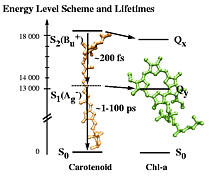Light Harvesting by Carotenoids
In light-harvesting complexes, carotenoids act as light-absorbers in the blue-green region of the spectrum. Absorption of a photon is followed by rapid singlet excitation energy transfer to bacteriochlorophyll (BChl). In addition to their light-harvesting role, carotenoids photoprotect antenna complexes, i.e., they prevent the formation of photo-oxidizing singlet oxygen by quenching BChl triplet states through triplet excitation transfer.
The energy levels of carotenoids and BChls
The energy levels of carotenoids and Chls depicted in the figure suggest two possible channels for singlet excitation transfer from carotenoids in LH2: transfer from the strongly absorbing S2 state of carotenoid to the Chl Qx state (S2 pathway) and transfer from the optically forbidden carotenoid S1 state to the Qy state (S1 pathway).
Excitation transfer from the S2 has to compete with extremely fast internal conversion from this state, while the excitation transfer from the S1 state is likely hindered by the optically forbidden nature of this state (and therefore vanishing transition dipole moment, and vanishing dipole-dipole coupling to the BChl).
Which one of the two pathways is more efficient in transfering excitation energy?
What is the mechanism of excitation transfer?
The answer to the red question is species dependent. For some species, e.g., Light-Harvesting Complex II of Rhodospirillum molischianum, the S2 pathway is dominant, while for some other species, e.g., Peridinin-Chlorophyll protein in Dinoflagellate A. Carterae, the S1 pathway is dominant.
Why do some species choose the S1 pathway, why some other choose the S2 pathway?
We have addressed this question through calculations which are based on a semi-empirical description of the electronic states of carotenoids and chlorophylls [1], [2].
We have also studied the mechanism of excitation transfer between carotenoids and chlorophylls [1]. The calculations show that the Coulomb mechanism exceeds the exchange mechanism and determines the rate of energy transfer in both the Purple Bacterial light-harvesting complexes and in the peridinin-chlorophyll-protein of Dinoflagellates.
Investigators
- Ana Damjanovic
- Thorsten Ritz




